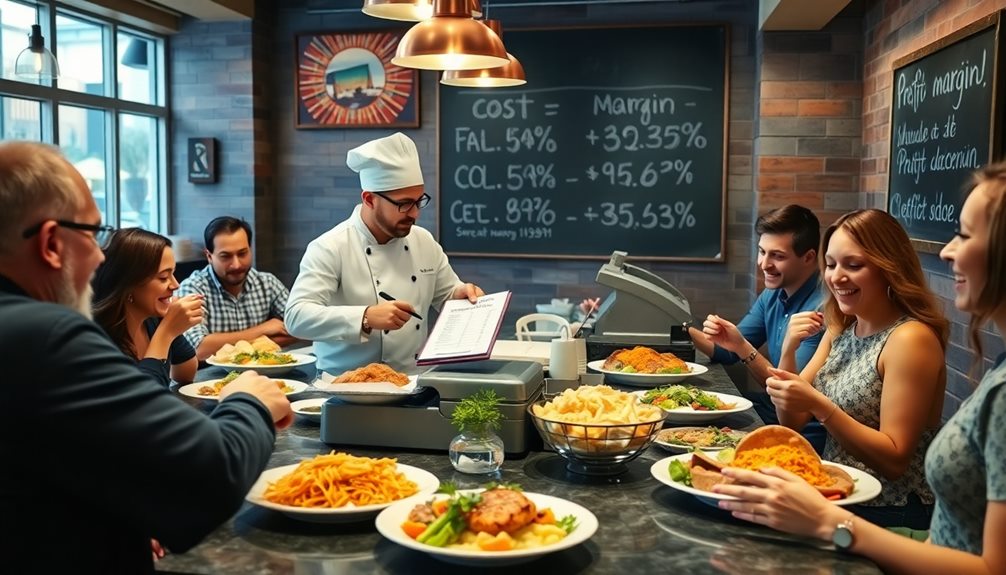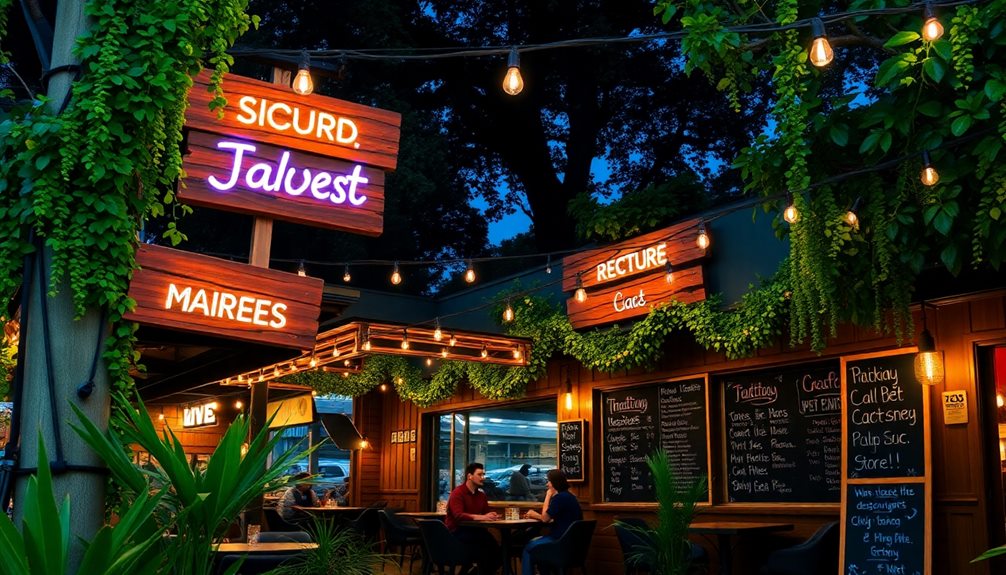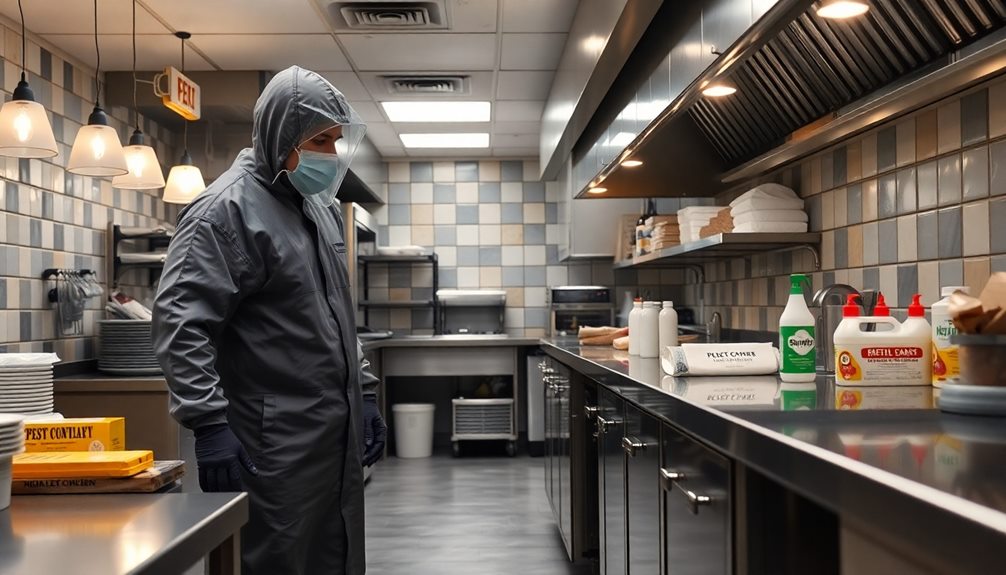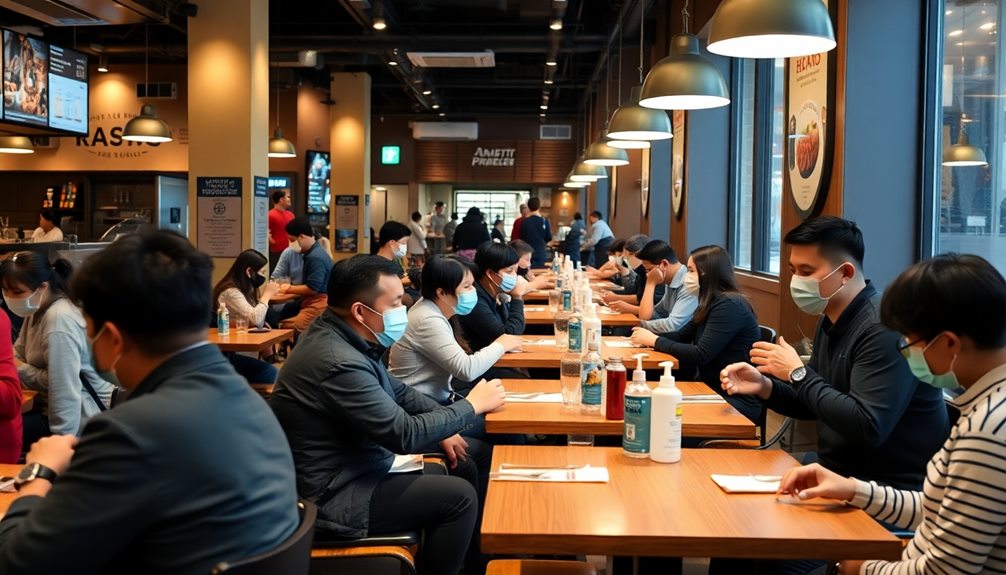A pop-up restaurant is a temporary dining venture that offers unique culinary experiences in unconventional spaces, like warehouses or parks. It's a great way to explore innovative concepts while gauging market interest. To start one, you'll need a clear concept, a suitable location, and the necessary permits. Focus on crafting an enticing menu and be prepared to adapt based on customer feedback. Marketing on social media and collaborating with local influencers can generate buzz. With careful planning and execution, your pop-up can stand out and succeed, opening doors to future culinary adventures waiting to be discovered.
Key Takeaways
- A pop-up restaurant is a temporary dining experience that operates for a limited time in unconventional venues.
- To start one, develop a unique concept that aligns with culinary trends and create a detailed business plan.
- Choose a suitable location based on target market appeal and conduct thorough market research to validate your concept.
- Ensure legal compliance by obtaining necessary permits, licenses, and adhering to health and safety regulations.
- Utilize effective marketing strategies like social media promotion and collaborations with local influencers to attract diners.
Definition of Pop-Up Restaurants

A pop-up restaurant is fundamentally a temporary dining experience that operates for a limited time, often in unexpected locations like warehouses or parks. This type of temporary dining establishment can last anywhere from a few hours to several months, providing you with the flexibility to adapt your operational goals based on customer interest.
Pop-up restaurants focus on unique themes, cuisines, or dining experiences, attracting adventurous diners enthusiastic for novel culinary offerings. These unique dining experiences create an exclusive atmosphere, drawing in food enthusiasts who want to be part of something special and fleeting.
To succeed, you'll need effective marketing strategies to generate buzz and urgency around your event. Social media plays a crucial role in this, allowing you to reach potential customers quickly and build excitement.
One key advantage of a pop-up restaurant is its lower financial risk and overhead costs compared to traditional restaurants. This allows you to test new concepts with minimal investment, making it easier to experiment with ideas without the fear of significant financial loss.
Benefits of Pop-Up Restaurants

Pop-up restaurants bring a host of benefits that appeal to both entrepreneurs and diners alike. For you as an aspiring restaurateur, the lower startup costs mean you can minimize long-term lease expenses and overhead while experimenting with innovative concepts.
These temporary venues create a sense of urgency, enticing diners to experience unique culinary offerings that are only available for a limited time. You can also test market responses effectively, showcasing your culinary talents without the commitment of a permanent location.
This flexibility allows you to refine your menu and approach based on immediate feedback. Revenue streams for pop-up restaurants are diverse, including ticketed events, limited menu sales, and partnerships with local vendors, giving you multiple income opportunities.
Moreover, pop-ups foster community engagement by collaborating with local businesses and participating in events. This not only enhances your brand visibility but also builds customer loyalty as you connect with your audience in meaningful ways.
Challenges in Starting a Pop-Up

Starting a pop-up restaurant presents numerous challenges that can test even the most determined entrepreneurs.
You'll face operational challenges, as limited resources and equipment can hinder service efficiency and affect the overall guest experience. Managing food and labor costs is another hurdle; fluctuating demand and short operational periods complicate accurate forecasting, leading to potential losses.
Establishing a repeat customer base might prove difficult since pop-up operations are typically sporadic. This inconsistency creates challenges in building loyalty among diners.
Additionally, legal compliance is essential. You'll need to navigate various permits and licenses that can vary by jurisdiction, which may cause delays and complicate your operations.
Your social media presence and marketing strategy will be critical for visibility. Attracting customers quickly within a limited timeframe requires creating buzz around your pop-up, which can be intimidating for newcomers.
Balancing all these elements is key to ensuring your pop-up restaurant not only opens successfully but also delivers a memorable guest experience. By understanding these challenges, you can prepare yourself to tackle them head-on, paving the way for a thriving pop-up venture.
Steps to Launch a Pop-Up
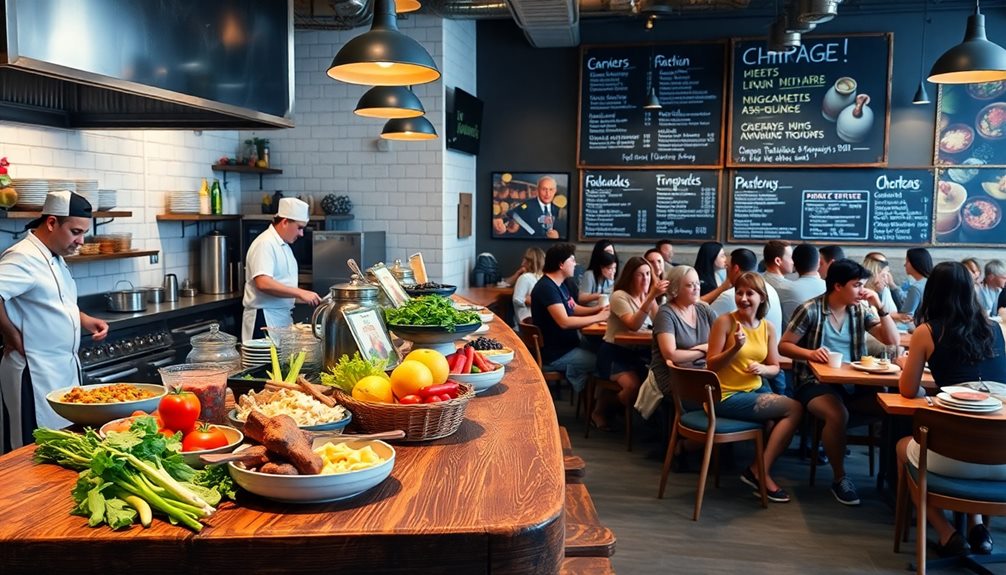
Launching a pop-up restaurant involves a series of strategic steps that can set the foundation for your success. First, select a unique concept that aligns with current culinary trends and resonates with your target audience. This could focus on specific cuisines or themes that promise a memorable dining experience.
Next, develop a thorough business plan that outlines your vision, operational goals, marketing strategy, and financial projections.
Once you've crafted your plan, it's time to choose a suitable location. Look for spaces that are accessible and appealing to your target market. Unconventional spots like parks or warehouses, or collaborations with existing restaurants for shared kitchen use, can be great options.
Don't forget to research and obtain the necessary licenses and permits specific to your area. Make sure you comply with health, safety, and zoning regulations to operate legally.
Key Considerations for Success
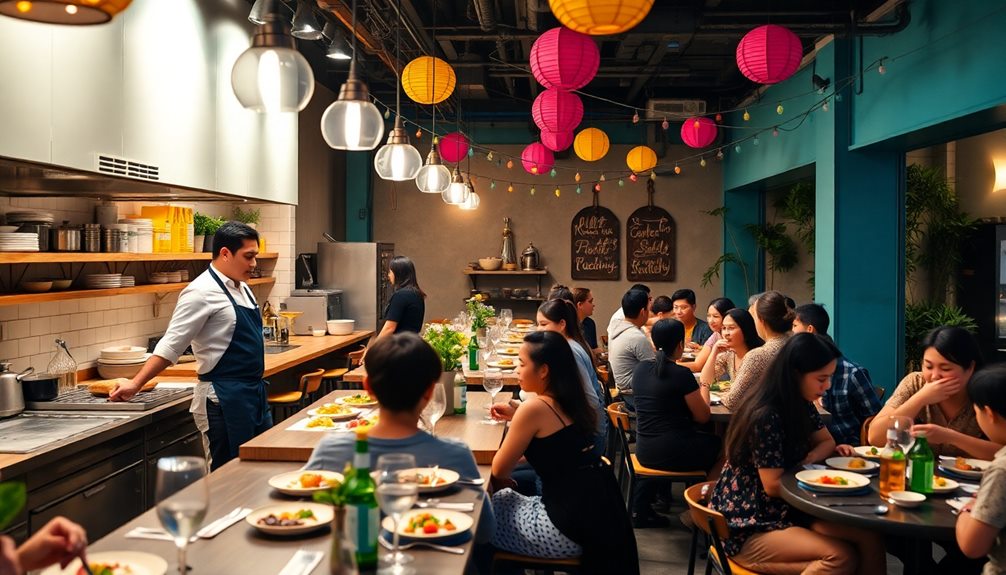
To make your pop-up restaurant a hit, you need to nail down key elements like location, menu, and legal requirements.
Start by picking a spot that resonates with your concept, then craft a menu that reflects current trends and local tastes.
Additionally, consider implementing a budget strategy to manage your expenses effectively and guarantee you have enough capital for your pop-up.
Don't forget to check off all necessary permits to confirm you're operating legally and smoothly.
Location Selection Essentials
How essential is the right location for your pop-up restaurant's success? It's critical. Your location selection greatly impacts visibility and helps you reach your target audience.
Think trendy neighborhoods, bustling food truck parks, or unique event venues—these spots can draw in enthusiastic diners. Confirm the space accommodates your desired layout and guest capacity while complying with zoning laws and safety regulations.
Consider collaborating with established businesses like bars or cafes; this can give you access to their kitchen space, reduce overhead costs, and attract their existing customers, boosting foot traffic.
To refine your strategy, conduct thorough market research. This allows you to align your pop-up with current culinary trends and local demand, tailoring your offering to the target demographic.
Don't overlook logistical factors. Evaluate parking availability, foot traffic, and proximity to public transportation, as these elements directly affect customer accessibility.
A well-chosen location not only enhances your restaurant's visibility but also sets the stage for a successful dining experience, making it essential to invest time and effort into this decision.
Menu Development Strategies
Choosing the right location sets the stage for your pop-up restaurant, but a well-crafted menu can truly make it unforgettable.
Effective menu development strategies are vital for creating a memorable dining experience. Here are key considerations to keep in mind:
- Focus on signature dishes that highlight your culinary strengths.
- Incorporate seasonal ingredients and local produce to guarantee freshness and support community suppliers.
- Utilize menu engineering to analyze costs and highlight high-margin items, maximizing profitability.
- Gather feedback on guest preferences to adapt your menu continuously, fostering customer loyalty.
Legal Compliance Checklist
Launching a pop-up restaurant requires careful attention to legal compliance, with at least five key considerations to keep in mind.
First, research local regulations to identify the specific licenses and permits you'll need, such as sales licenses and food handler permits. Some permits may be contingent on others, so establishing a timeline for obtaining these is vital to avoid delays in your opening.
Next, guarantee compliance with health and safety regulations, prioritizing food safety laws that govern food storage, preparation, and service. This will help you avoid fines or, worse, closure.
Additionally, consult with local government agencies to clarify zoning laws and confirm that your chosen location is compliant for food service operations.
Don't forget about liability insurance. It's important to protect yourself against potential legal issues or claims that could arise from food-related incidents during your pop-up's operation.
Marketing Strategies for Pop-Ups
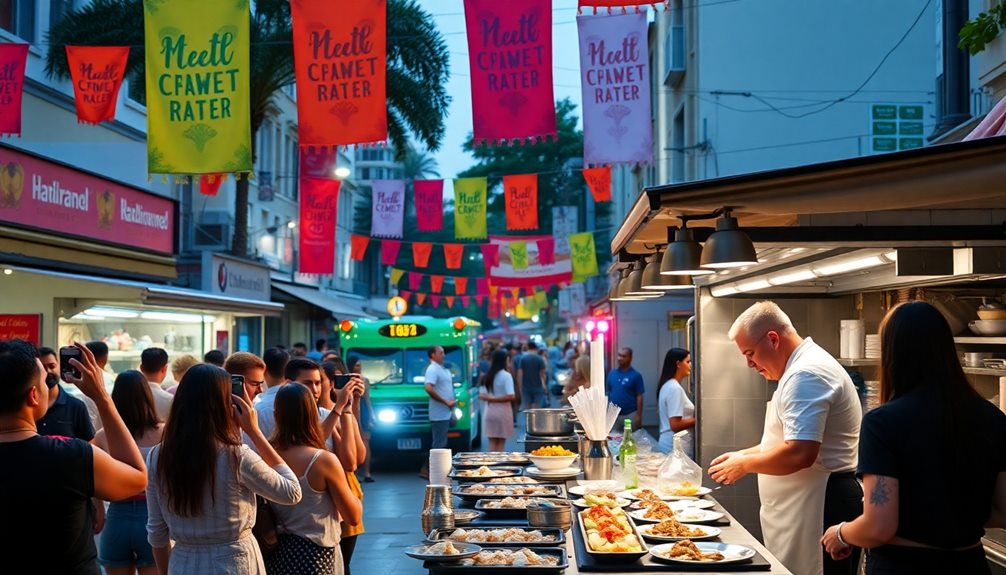
When it comes to marketing your pop-up restaurant, leveraging social media is essential for creating excitement and drawing in crowds. Utilize platforms like Instagram and Facebook to share mouthwatering visuals of your menu and unique dining experiences.
This strategy not only attracts a larger audience but also keeps your pop-up at the forefront of their minds. Additionally, being mindful of small mistakes, big impact in your promotional efforts can enhance your overall effectiveness and avoid common missteps that could hinder your success.
To effectively promote your event, consider these marketing strategies:
- Collaborate with local influencers to amplify your reach and enhance credibility.
- Implement pre-launch promotions like exclusive early-bird ticket sales to create urgency and encourage early reservations.
- Create an engaging website that offers online reservation options and features a blog for behind-the-scenes content.
- Gather customer feedback through surveys or social media interactions after the event to refine future strategies.
Operational Best Practices
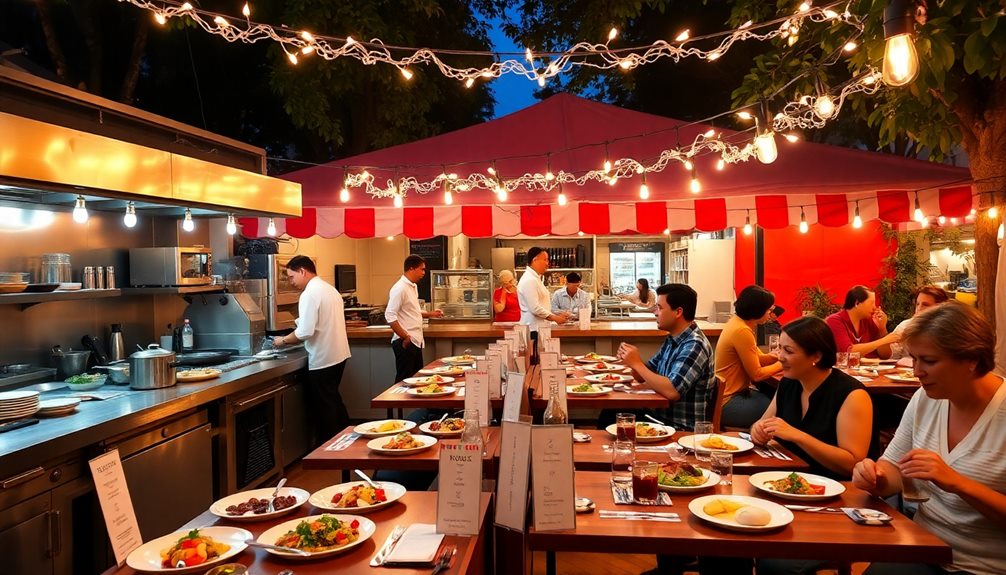
When running a pop-up restaurant, effective menu planning and efficient staffing can make all the difference. Properly organizing your offerings and ensuring that staff are well-prepared can improve service flow and customer satisfaction. Additionally, having a clear restaurant POS system overview helps manage orders, track inventory, and streamline payment processes, ensuring smoother operations. By integrating technology with thoughtful planning, you can enhance the overall dining experience and optimize profitability.
You'll want to create a menu that showcases your signature dishes while being mindful of ingredient availability and cost.
Additionally, optimizing your staff's roles during peak hours will help maintain smooth operations and enhance the overall guest experience.
Menu Planning Strategies
Effective menu planning is essential for the success of a pop-up restaurant, as it directly impacts both customer satisfaction and operational efficiency. To create an engaging dining experience, focus on these menu planning strategies:
- Develop a limited menu that highlights your signature dishes and seasonal ingredients, ensuring high-quality offerings. For inspiration, consider incorporating trendy options like Egg Rollup and Dumpling Sauce, which provides a protein-rich start to the day.
- Utilize menu engineering to analyze each dish's profitability and popularity. Adjust based on sales data and guest feedback to maximize revenue.
- Collaborate with local suppliers for fresh ingredients, fostering community ties while enhancing menu quality.
- Implement pre-ordering options to reduce wait times and streamline service, allowing guests to select meals in advance, which aids inventory management.
Regularly updating your menu in line with culinary trends and customer preferences can create excitement, encouraging repeat visits.
By honing in on these strategies, you'll not only maintain operational efficiency but also enhance the overall dining experience in your pop-up restaurant.
Efficient Staffing Techniques
Efficient staffing is essential for the success of your pop-up restaurant, especially given the fast-paced environment and limited operational window. To guarantee smooth operations, you should focus on hiring a flexible team with varied skill sets. This allows your staff to adapt to fast-paced environments and take on multiple roles as needed.
Utilizing industry job sites like Culinary Agents can help you attract qualified candidates, especially for seasonal or temporary staff. Implementing a thorough training program covering all operational aspects—like food safety, customer service, and menu knowledge—prepares your team for the pop-up's limited duration.
Fostering a positive work culture encourages open communication and feedback, improving morale and service quality. Additionally, using scheduling software can optimize staff coverage during peak dining hours while minimizing labor costs.
Here's a quick overview of efficient staffing techniques:
| Key Focus | Action Steps |
|---|---|
| Hire a Flexible Team | Look for candidates who adapt quickly |
| Training Program | Cover food safety, service, and menu details |
| Effective Scheduling | Use software for peak hour staff management |
Frequently Asked Questions
What Defines a Pop-Up Restaurant?
A pop-up restaurant's defined by its temporary nature, often set in unique locations. You'll experience limited menus, themed concepts, and a sense of urgency, enticing adventurous diners to enjoy exclusive culinary creations for a short time.
Are Food Pop-Ups Profitable?
Absolutely, food pop-ups can be quite profitable! With lower startup costs and a dash of creativity, you can whip up excitement, draw crowds, and watch your earnings rise like dough in a warm oven.
How Do Pop-Up Bars Make Money?
Pop-up bars make money through ticketed events, limited menus, and unique drink pairings. Collaborating with local breweries boosts profits, while merchandising and catering private events provide additional revenue streams, enhancing your brand's visibility and appeal.
How Do I Open a Pop-Up Bar?
Did you know 70% of consumers prefer unique dining experiences? To open a pop-up bar, develop a trendy concept, secure necessary permits, choose a great location, create a focused menu, and market effectively to attract customers.
Conclusion
Starting a pop-up restaurant can be both thrilling and intimidating. On one hand, you have the freedom to express your culinary creativity, but on the other, you face the pressure of limited time and resources. Embrace the excitement of bringing your vision to life while maneuvering through the challenges head-on. With careful planning and a dash of innovation, you can create an unforgettable dining experience that leaves a lasting impression—turning a temporary space into a cherished memory.


